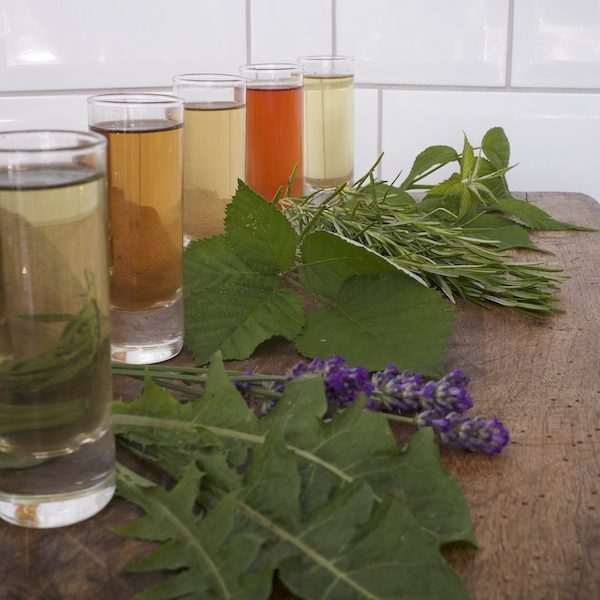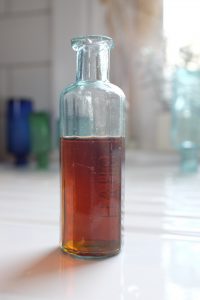
In a traditional skincare recipe a term like ‘toilet vinegar’ can sometimes stop us in our tracks. With a little investigating we can learn a lot to bring recipes into modern use.
When there weren’t preparations ready to buy off-the-shelf we were resourceful in using the ingredients we had to hand – in kitchen cupboards or growing in our gardens and hedgerows – to make what we needed. But I often find the recipes require some ‘adaptation’ to become something we’d really want to use today.
 Here’s an example from Rosa’s fantastic recipe book.
Here’s an example from Rosa’s fantastic recipe book.
Rosa was a long-time member of Stroud Beekeepers Association and much appreciated for her encyclopaedic knowledge and skill regarding honey. Thankfully over her lifetime Rosa compiled an amazing resource of honey-based recipes for all manner of edibles and practical household solutions which continues to intrigue and inspire.
Among these is this recipe for a hand lotion. It was passed to me for ‘interpretation’ with a question mark over ‘toilet vinegar’ – what is this?
What are toilet vinegars?
Toilet vinegars were a very popular and versatile way of incorporating herbal benefits into a recipe. They were created by packing your chosen herb, or herbs, into a jar and covering with vinegar. This was then sealed and left on a sunny windowsill with daily turning and shaking. Over the course of three to six weeks of this gentle treatment, the herbs will impregnate the vinegar with their special qualities. Often this will be seen through a colour change to the vinegar. When ready the herbs could be strained off (generally through a muslin) and the toilet vinegar would be ready to use.
For a stronger, longer lasting herbal vinegar, repeat the process using a fresh batch of herbs with the strained vinegar.
Your bottle of toilet vinegar could be sealed and kept in a cool dark place it would last for up to a year. This was therefore a good way to capture and store the benefits of seasonal herbs so they could be available throughout the year, not just in their short growing season. When added to a recipe toilet vinegars bring not only the astringent properties of the vinegar itself, but also the herbal benefits of whatever has been infused within it.

Herbs used in toilet vinegars
Often the herbs that you’ll find used in toilet vinegars are those that have distinct therapeutic properties but are only available for a few weeks of the year. These include:
Lavender – antiseptic and deodorising, refreshing and relaxing, good for acne and oily skin
Lemon balm – can be enlivening or calming and good for insect repellent
Rosemary – cleansing and firming, good for circulation and inflamed skin, a great hair tonic
Thyme – antiseptic, cleansing and refreshing
Rose Geranium – good for oily or inflamed skin, helps clean and improve circulation
Calendula – cleansing, healing, good for sunburn or inflamed skin
Peppermint – cleansing, cooling and deodorising
Traditional toilet vinegars
Some of the original ‘perfumes’ or ‘eau de colognes’ are a form of toilet vinegar. Hungary Water is perhaps the most famous of these, reputedly created for the Queen of Hungary. I’ve tried making different versions of this using either alcohol (vodka) or vinegar (apple cider vinegar). While I prefer the alcohol version for direct use, the vinegar version is lovely to splash into the bath.

Hungary water
25g fresh lemon balm leaves or 1 tbsp dried lemon balm
50g fresh rosemary leaves
1 fresh mint sprig (use only fresh – omit if you don’t have any)
Thinly pared rind of ½ lemon
300ml vodka
125ml orange flower water
125ml rosewater
Make: Chop the lemon balm and put all the herbs and the lemon rind in the bottom of a glass jar. Add the vodka, cover tightly and shake well. Leave in a warm place – or on a windowsill – for three weeks, remembering to shake it every day. Then strain and, as a last step, add the orange flower and rose water. Decant into a sterilised bottle.
Use: Splash and spritz all over for instant freshness and fragrance.
Store: Keep in a dark, cool place and use within six months.
Toilet vinegars are a great thing to have in your cupboard. You can use them directly (for example as a toner or hair conditioner – dilute the vinegar 1:4 with water) or include them in recipes, like the ones in this post.
So why were such lovely products called ‘toilet vinegars’?
Toilet vinegars have unfortunately suffered from an anglicisation of French.
We have long admired the elegance and sophistication of the French – particularly their perfumery and fashion. In times gone by much of the English aristocracy had French connections and this created a general assumption that to describe something using a French word gave it an air of grace and ‘je ne se quois’. When a lady sat down to beautify herself she performed her ‘toilette’, so it was that she used ‘toilette water’ and spritzed with ‘eau de toilette’. It can all sound so elegant when said in a French accent.
However, when misappropriated to the familiar English ‘toilet’ it sounds very different, somewhat functional and altogether less appealing. Don’t try googling ‘toilet vinegar’ unless you want lots of advice about the pros and cons of cleaning your toilet with vinegar.
Our changing language makes it much more appropriate to refer to traditional ‘toilet vinegars’ as ‘herbal vinegars’. Simple changes like this bring old fashioned recipes up to date and much more appealing and in-keeping with modern trends.
A modern herbal vinegar
In my book ‘Vital Skincare’ I focus on creating recipes that help us benefit from the herbs that grow around us. Sometimes I will take a recipe that uses tropical-grown ingredients and instead substitute appropriate ingredients from our own climate; other times I take a traditional recipe that uses temperate herbs and may update other ingredients and methods to make it more suitable for making today.
Here’s an example of a recipe for a Herbal Skin Tonic that is as refreshing and wonderful to use now as it would have been centuries ago. It combines a strong herbal vinegar with rosewater to create a lovely skin tonic. Used regularly it will help make skin more supple.
Herbal skin tonic
½ cup (118ml) white wine or cider vinegar
2 teaspoons (10g) dried rosemary
2 teaspoons (10g) dried lavender
2 teaspoons (10g) dried thyme
1 ¼ pints (710ml) rosewater
Make: Put half the herbs (1 teaspoon of each) into a glass jar and pour over the vinegar, making sure all the herbs are covered. Seal and leave for two weeks, shaking daily. Strain off the vinegar and put the remaining half of the herbs into a clean jar then cover with the herbal vinegar. Seal and again leave for two weeks, shaking daily. Strain and combine the herbal vinegar with the rosewater, bottle and seal.
Use: Use your herbal vinegar as a toner or add a couple of tablespoons full to a warm bath.
Store: Keep your vinegar in a well sealed bottle and store in the fridge for up to three months.
Rosa’s Recipe
So what do we make of Rosa’s recipe today?
Toilet vinegar
The recipe can be adapted to suit many purposes by varying the herbs used in the vinegar. As Rosa recommends this recipe for ‘whitening and softening’ the skin good herbs to use to aid this process would include elderflower, marshmallow or lime flower. I’d add a couple of tablespoons of water to reduce the acidity of the blend.
Lemon juice
A popular ingredient in traditional recipes, especially for its lightening effects, lemon juice is something that I avoid in skincare. It is very acidic so can burn skin if used too much. In this recipe I’d either omit the lemon juice or reduce the quantity to 1/2 tsp rather than 1/2 tbsp.
Glycerine
Great for skin softening due to its humectant qualities (draws in water). Adding glycerine will give a lovely silky quality to the herbal vinegar. In Rosa’s day glycerine was often made from animal bones, but now it is mostly produced synthetically from plant sources.
Honey
Of course Rosa would include honey and with good reason, it has great affinity with our skin. Another humectant it’s good to include in a moisturiser and it can also be healing and soothing too. It’s also packed with vitamins, minerals and antioxidants, although its exact properties will vary based on the nectar sources used in creating it.
Rosa’s recipe contains no butters or waxes so it makes quite a liquid lotion. You may need to shake it before use each time to ensure the ingredients are well combined but it’s well worth a try. Used little and often you should find your hands softening. The quantity is quite small so you can make fresh batches as you need them, perhaps varying the herbs you use in your vinegar to experiment with their different properties. Thank you Rosa.

